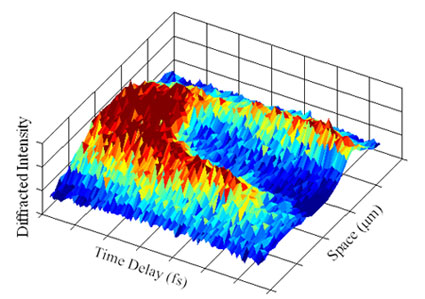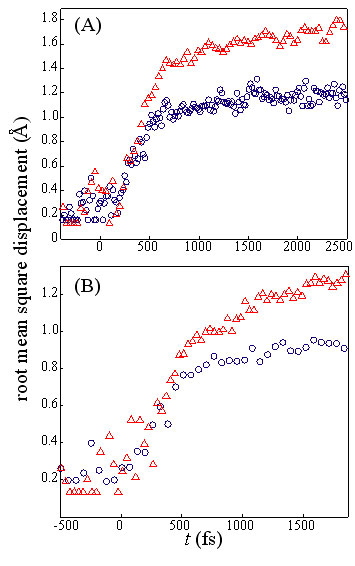

Constructing atomic scale mechanisms for chemical, biological, and physical
transformations of matter represents a critical goal for numerous scientific
and technological challenges that face modern society. The natural length and
time scale for atomic dynamics dictate that the scientific tools needed to
construct these mechanisms possess ┼ngstr÷m (┼) spatial resolution with
femtosecond (fs) temporal resolution. Ultrafast x-ray pulses provide the
necessary spatial and temporal resolution, but generating sources intense
enough for detailed structural studies has been a significant challenge.
The Sub-Picosecond Pulse Source (SPPS) represents the first utilization of a
linear electron accelerator to generate fs duration pulses of ┼ wavelength
light for studying structural dynamics. The per pulse fluence at the SPPS
exceeds that of all previous ultrafast hard x-ray sources by roughly two orders
of magnitude,[1] allowing structural transformations to be
investigated with unprecedented dynamical detail.
We have investigated the first steps in the laser driven solid-liquid
transition of an InSb semiconductor crystal. Intense fs laser excitation of
semiconductor crystals provides a pathway to crystal melting where the time
dependent evolution of the atomic structure can be monitored directly with
ultrafast x-ray diffraction [2-7]. While
pioneering fs x-ray diffraction experiments utilizing ultrafast laser plasma
sources have shown that crystals disorder faster than the rate of
electron-phonon coupling [5, 6] and ultrafast
optical measurements have observed liquid-like reflectivities on the
sub-picosecond time scale,[2, 8] the time
needed to generate liquid-like structure and dynamics remained unclear.
The comparatively large x-ray fluence and high time resolution at the SPPS has
greatly improved the data quality and led to an increased understanding of the
dynamical events that take place during the initial stages of electronically
driven melting. While the structural pathway followed during the crystal to
liquid phase transition has not been completely identified, the measurements to
date at the SPPS have been sufficiently detailed to bring into question the
theoretical models and molecular dynamics simulations that have provided the
primary description of electronically driven melting and support the commitment
to high brightness, ultrafast x-ray sources such as the Linac Coherent Light
Source (LCLS).
Studies of ultrafast laser melting at the SPPS demonstrate that the initial
stage of crystal disordering results from inertial motion on a laser softened
potential energy surface. The atoms initially sample the modified potential
with velocities determined by the lattice temperature prior to laser
excitation. These inertial dynamics dominate for the first half picosecond
following laser excitation, indicating that inter-atomic forces minimally
influence atomic excursions from the equilibrium lattice positions, even for
motions in excess of an ┼. These inertial dynamics result in a linear increase
in the root mean square (rms) displacement, as clearly shown in Figure 2. This
also indicates that the atoms disorder initially without losing memory of their
lattice reference. Interestingly, the time scale for inertial dynamics
coincides with the time scale for the increase in optical reflectivity in
InSb,[8] indicating that the increase in reflectivity results
from band gap collapse prior to the formation of a liquid structure. This
highlights the challenges present in utilizing the electronic response of a
material to access information about the atomic structure and the utility of
ultrafast x-ray diffraction.
Following the inertially driven decay in the diffraction intensity, we observe
an exponential decay. These biphasic dynamics occur for both Bragg peaks we
measured and for laser fluences ranging from 50 to 130 mJcm-2. This
exponential decay of the diffraction intensity corresponds to a rms
displacement that increases with a square root temporal dependence, consistent
with diffusive atomic motion. The experimental observation of diffusive motion
provides a signature for liquid-like motion.
The measurements of electronically driven melting at the SPPS also demonstrate
that the disordering proceeds anisotropically. After the first 500 fs, the rms
displacement (rmsd) in the [111] direction increases with a rate larger than
the rate in the [110] direction. This anisotropy cannot be explained with a
hard sphere model of atomic collisions, because the [111] direction disorders
faster despite the shorter inter-atomic distances. These observations have
provided an initial glimpse at the potential energy surface on which this phase
transition occurs. The initial results appear inconsistent with the expected
dynamics and anisotropy predicted by the theoretical model potentials used to
describe electronically driven melting [3]. These measurements
at the SPPS represent the most thorough experimental test to date of these
theoretical and simulation studies of non-thermal melting and demonstrate the
importance of high brightness, ultrafast x-ray probes of structural dynamics.
Primary Citations
A. M. Lindenberg, J. Larsson, K. Sokolowski-Tinten, K. J. Gaffney, C.
Blome, O. Synnergren, J. Sheppard, C. Caleman, A. G. MacPhee, D. Weinstein, D.
P. Lowney, T. K. Allison, T. Matthews, R. W. Falcone, A. L. Cavalieri, D. M.
Fritz, S. H. Lee, P. H. Bucksbaum, D. A. Reis, J. Rudati, P. H. Fuoss, C. C.
Kao, D. P. Siddons, R. Pahl, J. Als-Nielsen, S. Duesterer, R. Ischebeck, H.
Schlarb, H. Schulte-Schrepping, T. Tschentscher, J. Schneider, D. von der
Linde, O. Hignette, F. Sette, H. N. Chapman, R. W. Lee, T. N. Hansen, S.
Techert, J. S. Wark, M. Bergh, G. Huldt, D. van der Spoel, N. Timneanu, J.
Hajdu, R. A. Akre, E. Bong, P. Krejcik, J. Arthur, S. Brennan, K. Luening and
J. B. Hastings, "Atomic-Scale Visualization of Inertial Dynamics",
Science 308, 392 (2005)
References

Fig. 1: Single shot image of x-ray diffracted intensity from the (111)
Bragg peak of an InSb crystal. The ultrafast drop in diffracted intensity along
the central region of the diffracted image results from intense laser induced
disordering. The disordering occurs faster than the rate of energy transfer
from the excited electronic system to the crystal lattice, indicative of an
electronically driven melting mechanism, often termed non-thermal
melting.
While atomic diffusion could be signifying the initiation of liquid formation,
coherent Bragg diffraction will never definitively identify the time scale for
liquid formation, since a liquid with long range disorder will not generate
coherent Bragg diffraction. This will require time resolved measurements of the
liquid structure factor via x-ray diffuse scattering [9].

Fig. 2:
Time dependent root-mean square displacement measured with the (111) (D) and the (220) (O) Bragg
reflections. Data collected with laser fluences of 130 mJcm-2 (A) and 50 mJcm-2 (B).
K. J. Gaffney, A. M. Lindenberg, J. Larsson, K. Sokolowski-Tinten, C.
Blome, O. Synnergren, J. Sheppard, C. Caleman, A. G. MacPhee, D. Weinstein, D.
P. Lowney, T. Allison, T. Matthews, R. W. Falcone, A. L. Cavalieri, D. M.
Fritz, S. H. Lee, P. H. Bucksbaum, D. A. Reis, J. Rudati, A. T. Macrander, P.
H. Fuoss, C. C. Kao, D. P. Siddons, R. Pahl, K. Moffat, J. Als-Nielsen, S.
Duesterer, R. Ischebeck, H. Schlarb, H. Schulte-Schrepping, J. Schneider, D.
von der Linde, O. Hignette, F. Sette, H. N. Chapman, R. W. Lee, T. N. Hansen,
J. S. Wark, M. Bergh, G. Huldt, D. van der Spoel, N. Timneanu, J. Hajdu, R. A.
Akre, E. Bong, P. Krejcik, J. Arthur, S. Brennan, K. Luening and J. B.
Hastings, "Observation of Structural Anisotropy and the Onset of Liquidlike
Motion During the Nonthermal Melting of InSb", Phys. Rev. Lett.
5, 125701
(2005)
(e-mail: jbh@slac.stanford.edu).
| SSRL is supported by the Department of Energy, Office of Basic Energy Sciences. The SSRL Structural Molecular Biology Program is supported by the Department of Energy, Office of Biological and Environmental Research, and by the National Institutes of Health, National Center for Research Resources, Biomedical Technology Program, and the National Institute of General Medical Sciences. |